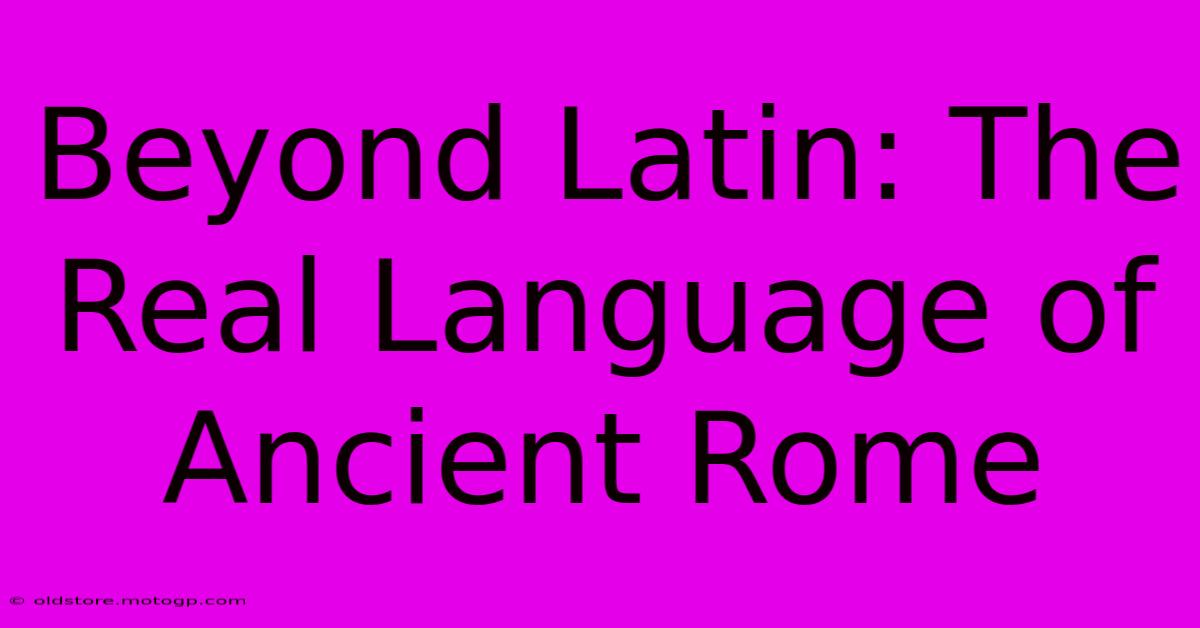Beyond Latin: The Real Language Of Ancient Rome

Table of Contents
Beyond Latin: The Real Language of Ancient Rome
For centuries, Latin has been synonymous with ancient Rome. We picture toga-clad senators eloquently debating in polished Latin, and legions marching to the rhythmic clang of Latin commands. But the reality of daily life in ancient Rome was far more nuanced, involving a vibrant tapestry of languages and dialects far beyond the formal Latin of literature and government. This article delves into the fascinating linguistic landscape of ancient Rome, revealing the “real” languages spoken by its diverse population.
The Official Tongue: Latin – But Not as You Know It
While Latin was indeed the official language of administration, law, and literature, it wasn't a monolithic entity. Classical Latin, the refined language of Cicero and Caesar, represented a high register, used primarily in formal settings. The everyday speech of the average Roman, however, was quite different. This colloquial Latin, sometimes referred to as Vulgar Latin, was far more informal, incorporating regional dialects, slang, and evolving grammatical structures. Think of the difference between formal English and the everyday slang you might hear on the street – the gap between Classical Latin and Vulgar Latin was similarly vast.
The Evolution of Vulgar Latin
Vulgar Latin wasn't simply "bad" Latin; it was a dynamic, living language constantly adapting to the needs and influences of its speakers. It varied significantly across the vast Roman Empire, giving rise to regional dialects that eventually evolved into the Romance languages we know today – French, Spanish, Italian, Portuguese, Romanian, and others. Studying Vulgar Latin helps us understand the roots of these modern languages and the linguistic processes that shaped them.
Beyond Latin: The Voices of the Empire
Rome's vast empire encompassed a multitude of cultures and languages. While Latin gained prominence, numerous other languages continued to be spoken throughout the empire. These languages weren't simply marginalized; they played crucial roles in daily life, commerce, and even administration in certain regions.
Greek: A Lingua Franca of the East
Greek, already a highly developed and prestigious language before Roman conquest, retained significant importance, particularly in the eastern parts of the empire. It served as a lingua franca, facilitating communication between diverse populations and maintaining its presence in administration, literature, and philosophy.
The Many Other Languages
Numerous other languages thrived within the Roman Empire, often leaving their marks on Latin itself through loanwords and linguistic influences. These included:
- Etruscan: A non-Indo-European language spoken in central Italy before Roman dominance, its influence on Latin vocabulary and culture is still debated but undeniable.
- Celtic languages: Various Celtic languages persisted in Gaul (France), Britain, and Iberia (Spain), interacting with Latin and contributing to the linguistic landscape.
- Punic: A North African language related to Phoenician, continued to be spoken in parts of the empire, leaving its trace in toponyms (place names) and vocabulary.
- Numerous other languages: From Germanic languages in the north to various languages of the Near East, the Roman Empire was a linguistic melting pot.
Uncovering the Past: Studying the Real Languages of Ancient Rome
Understanding the true linguistic reality of ancient Rome requires going beyond the idealized image of Classical Latin. Archaeological evidence, inscriptions, papyri, and the evolution of Romance languages provide crucial insights into the diverse languages and dialects spoken within the empire. This interdisciplinary approach, combining linguistics, history, and archaeology, allows us to reconstruct a more accurate and vibrant picture of the past, moving beyond the singular focus on Latin to appreciate the multifaceted linguistic landscape of ancient Rome.
In conclusion, while Latin undeniably held significant political and cultural importance, the "real" language of ancient Rome was a vibrant mosaic of languages reflecting the diverse populations and cultures that constituted the empire. By exploring this complex linguistic tapestry, we gain a richer and more accurate understanding of Roman history and the enduring legacy of its empire.

Thank you for visiting our website wich cover about Beyond Latin: The Real Language Of Ancient Rome. We hope the information provided has been useful to you. Feel free to contact us if you have any questions or need further assistance. See you next time and dont miss to bookmark.
Featured Posts
-
The Ultimate Guide To Miller Lite Alcohol Content Calories And More
Feb 10, 2025
-
Want To Understand The Godfather Read The Family Mario Puzo
Feb 10, 2025
-
Beyond The Hedge The Turtles Guide To Suburban Survival
Feb 10, 2025
-
Fine Arts Building Chicago Ignite Your Artistic Passion
Feb 10, 2025
-
John Paul Ii Airport Poland Your Gateway To European Adventure
Feb 10, 2025
